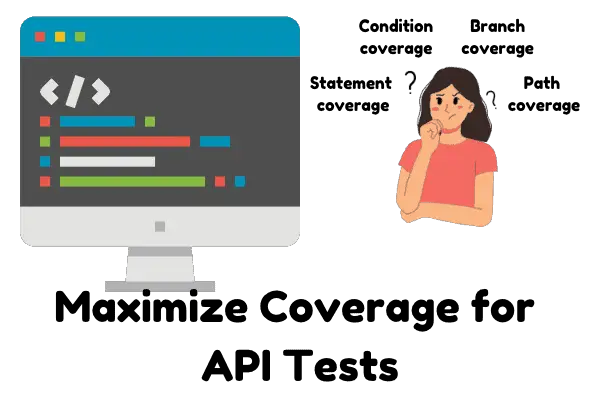
Are you an API testing aficionado looking for ways to supercharge your test coverage? Let this article help you! In this comprehensive guide, we’ll delve into actionable strategies to enhance your API test coverage. With the rising prominence of APIs in modern software development, ensuring their reliability and quality is more crucial than ever. We’ll begin with a quick refresher on API testing before diving into technical methods and best practices to help you identify gaps in your test coverage. Get ready to embark on an API testing journey that will lead to tangible improvements and a more robust testing process.
Part 1: A Quick Refresher on API Testing
- API testing in a nutshell: APIs, or Application Programming Interfaces, are the critical building blocks in today’s software systems, acting as bridges for communication and data sharing between different applications and services. If you’re eager to learn more about APIs and their inner workings, our guide on APIs made simple is the perfect starting point.API testing focuses on assessing the functionality, performance, security, and reliability of these interfaces to ensure they meet the required specifications.
If API testing seems a bit confusing or overwhelming right now, don’t worry! Our beginner’s guide to API testing is a fantastic resource to help you get started on the right foot. Remember, API tests serve various purposes, including unit, integration, functional, load, security, compliance, and exploratory tests.To better understand the REST API, read our article on breaking REST API into components for a beginner. - The significance of test coverage: Test coverage is a critical metric that reflects the extent to which your tests exercise the different components of your software system. High test coverage is vital for ensuring the overall quality and reliability of your APIs. There are several types of test coverage, including statement, branch, condition, and path coverage.Achieving high test coverage guarantees that your APIs are thoroughly tested, and potential issues are identified and addressed early in the development process. This proactive approach minimizes the risk of defects seeping into the final product, which could lead to poor user experiences and increased maintenance costs.
Now that we’ve refreshed your memory on the basics of API testing and the importance of test coverage, let’s dive into the heart of this article and explore various strategies to boost your API test coverage!
Part 2: Technical Strategies to Improve API Test Coverage

- Think like a detective with test case design: To unravel the mysteries of high test coverage, start by designing effective test cases that leave no stone unturned. Crafting well-thought-out test cases can significantly improve the quality and reliability of your APIs. Focus on the following aspects to enhance your test case design:
- Positive, negative, and edge case testing: Ensure your test cases cover both positive (expected functionality) and negative (error handling) scenarios. Don’t forget edge cases that test the limits of your API, such as maximum or minimum input values or unusual combinations of inputs. For more details on designing effective test cases, read our comprehensive guide on API test design.
- Parameterization and data-driven testing: Parameterization and data-driven testing involve using different input values, or data sets, in your API tests to validate the API’s behavior under various scenarios. By testing your API with a wide range of input values, you can more thoroughly evaluate its functionality and uncover potential issues that might otherwise be missed.
- Use realistic data sets: When creating data sets for your API tests, use realistic values that are representative of the types of data your API will encounter in production.
- Test edge cases and boundary conditions: Ensure your data sets include edge cases and boundary conditions to test how your API behaves when given unexpected or extreme input values.
- Automate data-driven testing: Use tools and libraries that support data-driven testing, such as Postman, JUnit, or TestNG, to automate the process and improve the efficiency of your API tests.
- Prioritize test cases based on risk and impact: Focus on high-priority test cases that address critical functionality, high-risk areas, and the most common use cases. Prioritizing your test cases ensures that the most important aspects of your API receive adequate attention and testing.
- Embrace comprehensive API documentation: Comprehensive and up-to-date API documentation is critical for creating effective test cases and maintaining high test coverage. API documentation should cover all the necessary details, such as endpoint URLs, request and response formats, authentication mechanisms, error codes, and usage examples.
- Use API documentation to identify gaps: Regularly review your API documentation to identify gaps in test coverage and update your test cases accordingly.
- Leverage API documentation tools: Use tools like Swagger or Postman to automatically generate and maintain your API documentation, ensuring it stays up-to-date and accurate throughout the API’s lifecycle.
- Adopt a test-driven development (TDD) approach: By writing tests first, developers can ensure that their code meets the required specifications, leading to higher test coverage and fewer defects.
- Write tests for new functionality: Whenever new functionality is added to the API, create tests to cover the expected behavior and edge cases before writing the actual code.
- Refactor and improve tests: As you refine and update your API, revisit your existing tests to ensure they still align with the current requirements. Make improvements and adjustments as needed to maintain high test coverage.
- Implement automation: Automation is essential for maintaining high test coverage, especially as your API evolves and grows in complexity. Automated tests can quickly and efficiently execute a large number of test cases, ensuring comprehensive coverage with minimal manual effort. Consider the following aspects of automation:
- Benefits of automation in API testing: To point out the obvious, automation saves time, reduces human error, and provides faster feedback on the quality of your APIs. Read our article on the benefits of automated API testing to understand (or convince your team) why you need API testing in your delivery process.
- Selecting the right automation tools: There are numerous API testing tools available, each with its own strengths and weaknesses. It’s essential to choose the right tool that aligns with your project requirements, technology stack, and team expertise. Our comprehensive guide on choosing the right performance testing tools can help you make an informed decision.
- Integrating API testing into CI/CD pipelines: By weaving your API tests into your Continuous Integration (CI) and Continuous Deployment (CD) pipelines, you’re making sure that your APIs get tested automatically with each code update. This way, you’ll catch any issues as they arise, making your API testing process more efficient and effective.
- Leverage code coverage analysisCode coverage analysis is a technique that can help you measure the effectiveness of your API tests by determining the extent to which your test cases cover your application’s code. Four types of code coverage are particularly useful for API testing: statement coverage, branch coverage, condition coverage, and path coverage. By analyzing these coverage metrics, you can identify areas where your tests may be lacking and make improvements to increase test coverage.
- Statement coverage: Statement coverage measures the number of lines of code executed by your tests. To improve statement coverage, ensure that your tests cover all the possible paths in your API, including error handling and edge cases.
- Branch coverage: Branch coverage examines the number of branches, or decision points, in your code that are covered by your tests. Enhance branch coverage by creating test cases for all possible outcomes of each decision point, including success and failure scenarios.
- Condition coverage: Condition coverage focuses on the various conditions within decision points in your code, like the different parts of an
if-elsestatement. To improve condition coverage, ensure your tests cover all possible outcomes of each condition. - Path coverage: Path coverage measures the number of unique paths through your code that are executed by your tests. To increase path coverage, create test cases that cover every possible combination of paths through your API.
Following these technical strategies can certainly help, however, implementing these strategies is just the beginning. To truly excel at API testing, it’s crucial to adopt best practices and continuously improve your testing processes. In the next section, we’ll delve into best practices and process improvements that can further boost your API test coverage.
Part 3: Best Practices for Boosting API Test Coverage

- Foster collaboration between developers and testers: To maximize test coverage, it’s essential to encourage close collaboration between developers and testers. This collaboration ensures that both parties understand the API requirements, functionality, and potential risks, leading to more effective test cases and higher test coverage.
- Pair programming: When a developer and tester team up to work on the same code, it’s called pair programming. This approach helps to close the gap between development and testing, leading to a deeper understanding of the API and, as a result, improved test coverage. It’s like joining forces to make your API testing process even more efficient and effective!
- Frequent communication: Software development is an extremely fast paced and change prone process (and for good reason). Unfortunately, because of this reason, cracks in your strategy can develop, widen and damage your application testing quality if the testing coverage does not keep up with all tiny decisions impacting the APIs. Regular feedback sessions can help keep everyone on the same page and facilitate the testing stay on top of these cracks before they can become problems.
- Continuously monitor and analyze test results: Regularly monitoring and analyzing your test results can help you identify areas of low test coverage, potential bottlenecks, and recurring issues. Use this information to adjust your testing strategy and address any gaps in test coverage.
- Leverage analytics tools: Use analytics tools to monitor test coverage, analyze trends, and identify areas for improvement.
- Learn from past experiences: Continuously evaluate your testing process to identify patterns, recurring issues, and areas of improvement. Use this information to refine your testing strategy and boost test coverage.
- Stay current with API testing techniques and tools: API testing is a rapidly evolving field, with new techniques, tools, and best practices emerging regularly. It should not be a surprise that if you are not moving with the rapid changes, your strategy (and coverage) will very soon not be effective and pretty soon – obsolete.
- Participate in industry events and conferences: Attend API testing conferences, webinars, and workshops to stay informed about the latest trends and best practices.
- Subscribe to relevant blogs and newsletters: Follow industry-leading blogs and subscribe to newsletters to receive the latest API testing news, insights, and best practices in your inbox.
Part 4: Continuously Improve Your Testing Process
- Conduct regular test coverage audits: Periodically audit your test coverage to identify gaps and areas for improvement. Make the Japanese concept of ‘Kaizen’ (small, positive, continuous improvement) a part of your team’s culture.
- Track test coverage metrics: Measure and track test coverage metrics, such as statement, branch, condition, and path coverage, to gauge the effectiveness of your testing process.
- Adjust your testing strategy: Based on the results of your test coverage audits, make the necessary adjustments to your testing strategy to address gaps and improve test coverage.
- Learn from your mistakes: When issues arise or defects are discovered, analyze the root cause to identify any gaps in your testing process.
- Conduct post-mortem analyses: After each testing cycle, conduct a post-mortem analysis to identify what went well, what could have been better, and any lessons learned.
- Implement corrective actions: Based on the findings from your post-mortem analyses, implement corrective actions to address gaps and improve your testing process.
Conclusion
Achieving high API test coverage is critical for ensuring the quality and reliability of your APIs. By following the technical strategies, best practices, and process improvements outlined in this comprehensive guide, you can significantly boost your API test coverage and deliver robust, reliable APIs that meet the demands of today’s fast-paced software development landscape. Remember, the key to success lies in continuous learning, improvement, and collaboration. Keep exploring, experimenting, and innovating to stay ahead of the curve and excel in the world of API testing.

